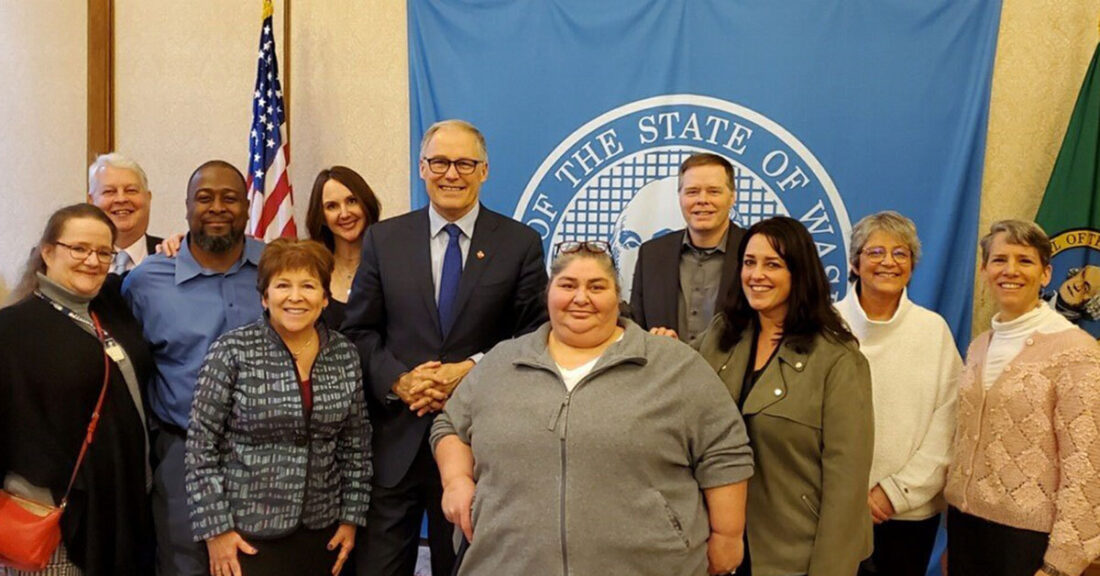Results Count Program Informs Plan to Eradicate Poverty in Washington

Governor Jay Inslee of Washington state (center) and Lori Pfingst, senior director with DSHS (to Inslee's right) join members of the governor’s executive cabinet and co-chairs of the Poverty Reduction Work Group.
In Washington state, Governor Jay Inslee’s Poverty Reduction Work Group has released a comprehensive 10-year plan to dismantle poverty statewide. The group’s main facilitator and writer, Lori Pfingst, credits one program — Results Count® — with shaping her work on the project.
About Results Count
Results Count is a results-based leadership development program from the Annie E. Casey Foundation. It teaches decision makers like Pfingst, who attended the Foundation’s Leadership Institute for State-based Advocates in 2014, how to leverage data to realize concrete goals. Participants learn a range of skills, including how to hold a neutral stance to help a large group stay focused on top-level goals; collect the best available data and bring it to life with stories from people disproportionately affected by poverty; and facilitate difficult conversations about structural racism and intersectionality. Pfingst used all of these skills to help shape Washington’s 10-year plan, she says.
Tools from Results Count programs, available on Casey’s website, include webinars, videos and checklists designed to help leaders get large-scale results for children, families and communities.
Representation Matters
Work on the plan began in November 2017, when Governor Inslee created the work group to develop “a strategic plan to reduce poverty, improve communities and make needed progress related to housing, health integration, employment and education.”
Helming the effort: 22 steering committee members who represented — both demographically and geographically — a range of poverty experiences within the state. “We agreed that people who were disproportionately affected by poverty should have the power and authority to oversee and approve the plan’s priorities and recommendations,” says Pfingst, a senior staffer at the Washington State Department of Social and Health Services. “The work group made a strong commitment to race and social justice from the outset and committed to going deep on equity to ensure the plan would lead to a more just future.”
Examining the Evidence and Root Causes
In February 2020, the work group released a preliminary version of the plan and followed with 10 months of public webinars during the COVID-19 pandemic. This outreach, which intentionally engaged people disproportionately affected by poverty, helped to strengthen the document’s strategies and recommendations. “I presented the plan close to 70 times via Zoom,” says Pfingst, “and the feedback was overwhelmingly positive and constructive.”
Webinar participants also helped to identify blind spots in official data. For example, the U.S. Census Bureau does not collect data on gender identity, undermining efforts to measure poverty rates in the LGBTQ community. Information on poverty among people with disabilities is also limited. “There are people who just aren’t well represented in the data,” says Pfingst, “and they need to be visible.”
The revised 70-page plan, released in January 2021, proposes eight poverty-reduction strategies and 60 specific recommendations for government agencies, legislators, community-based organizations and foundations. Centered on racial equity, the plan discusses the root causes of poverty and the urgent needs of the state’s 1.75 million children, adults and families who are currently struggling to make ends meet.
A Living Document
Results Count methodologies are particularly evident in the 10-year plan’s Action Toolkit, an implementation guide for public, private and nonprofit organizations. The tool kit is designed to help organizations:
- understand how their work aligns with the plan’s eight strategies;
- disaggregate data as much as possible;
- analyze disaggregated data with the people it represents;
- set specific goals and define success;
- identify additional resources and partnerships needed;
- develop equitable strategies to achieve stated goals;
- create an action plan with defined roles, responsibilities and a timeline;
- track progress and change strategies as needed;
- be accountable and learn from mistakes; and
- celebrate wins.
The work group calls the 10-year plan a “living, breathing document” and intends to revisit the text annually to refine its strategies and recommendations.
“The work group’s plan and action tool kit are impressive, much-needed contributions that can help fuel equitable, measurable progress in reducing poverty,” says Barbara Squires, director of Leadership Development at the Casey Foundation. “Equally remarkable: The plan’s engagement with the very people most affected by poverty can help them drive the change they need and want to see.”





